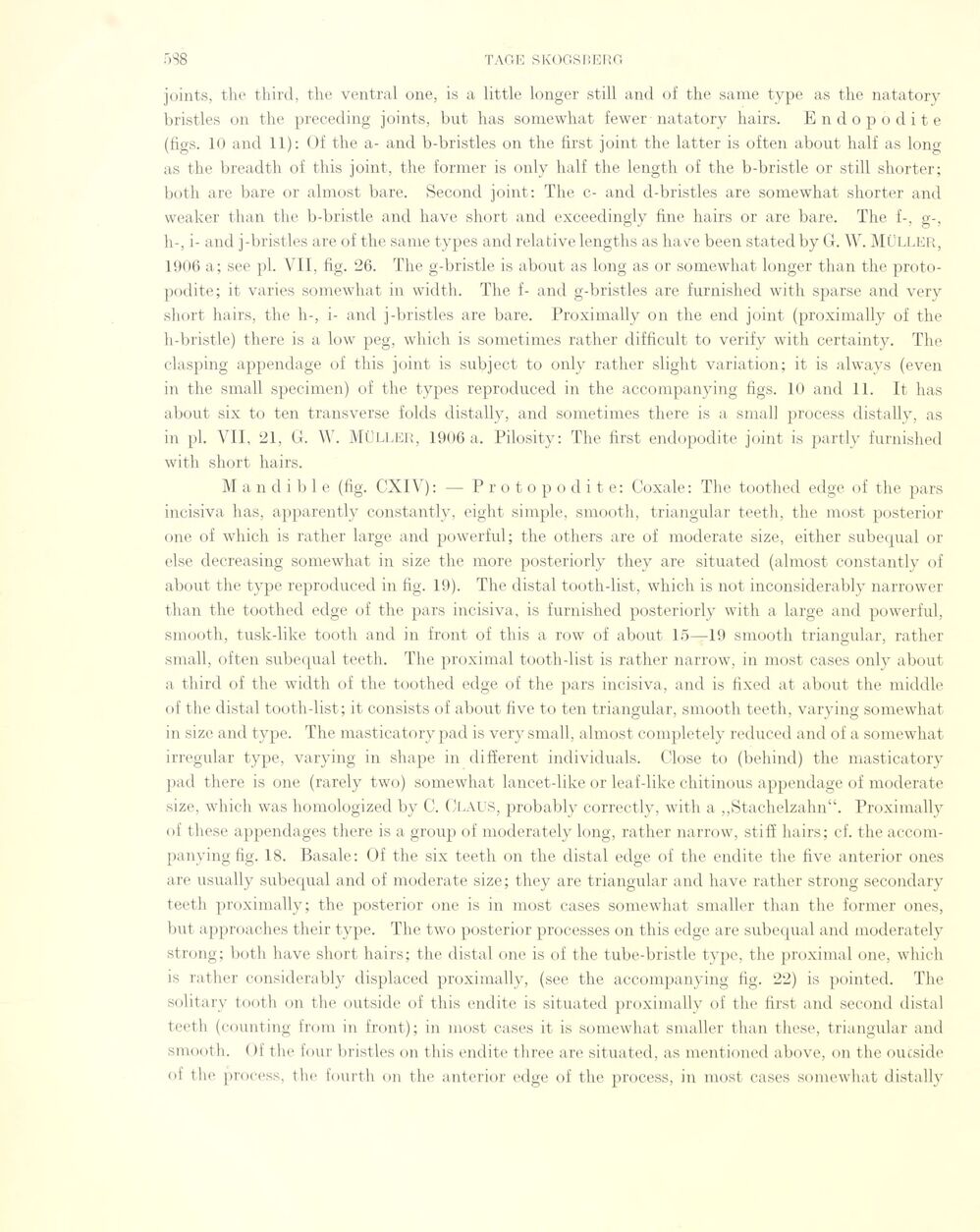
Full resolution (JPEG) - On this page / på denna sida - Sidor ...

<< prev. page << föreg. sida << >> nästa sida >> next page >>
Below is the raw OCR text
from the above scanned image.
Do you see an error? Proofread the page now!
Här nedan syns maskintolkade texten från faksimilbilden ovan.
Ser du något fel? Korrekturläs sidan nu!
This page has never been proofread. / Denna sida har aldrig korrekturlästs.
joints, the third, the ventral one, is a little longer still and of the same type as the natatory
bristles on the preceding joints, but has somewhat fewer natatory hairs. Endop odite
(ligs. 10 and 11): Of the a- and b-bristles on the first joint the latter is often about half as long
as the breadth of this joint, the former is only half the length of the b-bristle or still shorter;
botli are bare or almost bare. Second joint: The c- and d-bristles are somewhat shorter and
weaker than the b-bristle and have short and exceedingly fine hairs or are bare. The f-, g-,
h-, i- and j-bristles are of the sanie types and relative lengths as have been stated by G. W. MÜLLER,
1906 a; see pl. VII, fig. 26. The g-bristle is about as long as or somewhat longer than the
protopodite; it varies somewhat in width. The f- and g-bristles are furnislied with sparse and very
short hairs, the h-, i- and j-bristles are bare. Proximally on the end joint (proximally of the
h-bristle) there is a low peg, which is sometimes rather difficult to verify with certainty. The
clasping appendage of this joint is subject to only rather slight variation; it is always (even
in the small specimen) of the types reproduced in the accompanying figs. 10 and 11. It has
about six to ten transverse folds distally, and sometimes there is a small process distally, as
in pl. VII, 21, G. W. MÜLLER, 1906 a. Pilosity: The first endopodite joint is partly furnislied
with short hairs.
M a n d i b 1 e (fig. CXIV): — Protopodite: Coxale: The toothed edge of the pars
incisiva has, apparently constantlv, eight simple, smooth, triangulär teeth, the most posterior
one of which is rather large and powerful; the others are of moderate size, either subequal or
else decreasing somewhat in size the more posteriorly they are situated (almost constantly of
about the type reproduced in fig. 19). The distal tooth-list, which is not inconsiderably narrower
than the toothed edge of the pars incisiva, is furnislied posteriorly with a large and powerful,
smooth, tusk-like tooth and in front of this a row of about 15—19 smooth triangulär, rather
small, often subequal teeth. The proximal tooth-list is rather narrow, in most cases only about
a third of the width of the toothed edge of the pars incisiva, and is fixed at about the middle
of the distal tooth-list; it consists of about five to ten triangulär, smooth teeth, varying somewhat
in size and type. The masticatory pad is very small, almost completely reduced and of a somewhat
irregulär type, varying in shape in different individuals. Close to (behind) the masticatory
pad there is one (rarely two) somewhat lancet-like or leaf-like chitinous appendage of moderate
size, which was homologized by C. CLAUS, probably correctly, with a „Stachelzahn“. Proximally
of these appendages there is a group of moderately long, rather narrow, stiff hairs; cf. the
accompanying fig. 18. Basale: Of the six teeth on the distal edge of the endite the five anterior ones
are usually subequal and of moderate size; they are triangulär and have rather strong secondary
teeth proximally; the posterior one is in most cases somewhat smaller than the former ones,
but approaches their type. The two posterior processes on this edge are subequal and moderately
strong; both have short hairs; the distal one is of the tube-bristle type, the proximal one, which
is rather considerably displaced proximally, (see the accompanying fig. 22) is pointed. The
solitary tooth on the outside of this endite is situated proximally of the first and second distal
teeth (counting from in front); in most cases it is somewhat smaller than these, triangulär and
smooth. Of the four bristles on this endite three are situated, as mentioned above, on the oucside
of the process, the fourth on the anterior edge of the process, in most cases somewhat distally
<< prev. page << föreg. sida << >> nästa sida >> next page >>